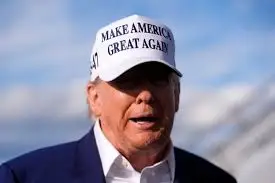WATCH: Trump says US wants to make ‘tanks, not T-shirts’ as he defends tariff policy

Former President Donald Trump recently doubled down on his administration’s controversial tariff policies by emphasizing the United States’ need to prioritize heavy manufacturing and defense production over cheap consumer goods. His now-famous declaration, “We want to make tanks, not T-shirts,” captures a core philosophy driving his trade approach: rebuilding America’s industrial base to strengthen economic security and national defense.
The Tariff Policy Backdrop
Throughout his presidency, Donald Trump pushed tariffs aggressively as a tool to protect American industries from what he described as unfair trade practices, particularly targeting China, the European Union, and other trading partners. The tariffs covered a wide range of products, including steel, aluminum, electronics, and other goods critical to manufacturing and infrastructure.
Critics argued that tariffs increased costs for consumers and businesses and risked provoking retaliatory measures that could hurt American exporters. Supporters, however, viewed the tariffs as essential to stopping the decline of U.S. manufacturing and bringing jobs back home.
In his recent remarks defending the tariffs, Trump framed the issue not just as economic policy but as a matter of national importance. “We’re not here to make cheap T-shirts,” he said, “We want to produce tanks, airplanes, and technology that keeps America strong and independent.”
Manufacturing as a National Priority
Trump’s statement reflects a broader strategic priority that gained traction during his administration: reviving the U.S. manufacturing sector, particularly in industries tied to national security. Over the past several decades, globalization and outsourcing led to significant declines in manufacturing employment, which many communities experienced as economic decline.
By imposing tariffs, the Trump administration aimed to make American manufacturing more competitive and reduce reliance on foreign supply chains, especially for critical goods. The administration argued that manufacturing jobs not only provide economic stability but also serve as the backbone for defense readiness and technological leadership.
“Manufacturing is the heart of our economy and the foundation of our national security,” Trump said. “If we lose our ability to produce critical equipment like tanks and military hardware, we lose our ability to defend ourselves.”
Economic and Political Implications
The tariff policy sparked a heated debate among economists and policymakers. On one hand, tariffs can protect domestic industries from dumping and unfair subsidies by foreign competitors. They can also encourage companies to invest in American production facilities, leading to job creation.
On the other hand, tariffs often increase the cost of imported raw materials and components, which can raise production costs for downstream industries. Consumers may also face higher prices on goods that depend on international supply chains. Moreover, trade partners sometimes retaliate with their own tariffs, which can hurt American exporters.
Despite these risks, Trump and his supporters maintained that the long-term benefits of revitalizing manufacturing outweighed short-term economic costs. The goal was to create a more self-sufficient and resilient economy less vulnerable to external shocks.
Impact on Key Industries and Workers
The industries most affected by the tariffs included steel and aluminum production, automotive manufacturing, and defense contractors. Steel tariffs, in particular, were intended to revive American mills and protect jobs in states with large manufacturing bases.
Defense-related manufacturing saw renewed emphasis as well. The push to “make tanks” rather than importing military equipment ties directly to concerns about maintaining technological superiority and securing supply chains for critical defense components.
Many workers in manufacturing hubs welcomed the tariffs as a lifeline for struggling communities. Job growth in steel production and related sectors did see some improvements during the period of tariff enforcement. However, some industries reliant on imported parts faced challenges due to increased costs and supply chain disruptions.
Broader Trade Strategy and National Security
Trump’s remarks also shed light on the increasingly close relationship between trade policy and national security considerations. The COVID-19 pandemic and geopolitical tensions have heightened awareness about vulnerabilities in global supply chains, especially for essential goods like medical equipment, semiconductors, and defense hardware.
The call to focus on manufacturing “tanks, not T-shirts” is symbolic of this shift. It underscores a desire to prioritize industries critical to national defense and infrastructure over low-cost consumer goods that are easily outsourced.
Experts note that securing supply chains and building domestic production capabilities have become bipartisan concerns, though the means to achieve them remain contested. Tariffs, subsidies, tax incentives, and direct government investment are all tools debated in policy circles.
Challenges and Criticisms
While the intent behind tariffs may have strategic merit, the policy approach is not without criticism. Some economists argue that tariffs are blunt instruments that can cause collateral damage by raising costs across the economy.
Retaliatory tariffs from trading partners led to trade disputes and uncertainty for exporters, particularly in agriculture and technology sectors. Additionally, some businesses struggled with supply chain disruptions and higher input costs, which occasionally translated into higher consumer prices.
Critics also contend that tariffs alone cannot solve deeper structural issues facing U.S. manufacturing, such as workforce skill gaps, automation, and innovation challenges. Long-term competitiveness depends on investment in technology, education, and infrastructure beyond protectionist measures.
Looking Forward: The Future of American Manufacturing and Trade
As the U.S. continues to navigate complex global trade dynamics, the balance between protecting domestic industries and engaging in open markets remains delicate. The Trump administration’s tariff policies marked a shift toward economic nationalism and a more assertive trade stance.
Today, many policymakers still emphasize the need to strengthen American manufacturing, especially in strategic sectors like defense, semiconductors, and renewable energy. However, future approaches may favor more targeted incentives and multilateral cooperation alongside trade restrictions.
The phrase “make tanks, not T-shirts” will likely continue to resonate as a shorthand for prioritizing industries vital to national security and economic independence. Whether through tariffs, subsidies, or innovation-driven policies, the goal remains clear: to ensure the United States maintains a strong and resilient industrial base in a rapidly changing global landscape.






